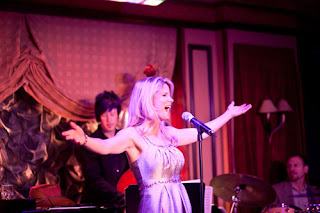
BY MARY SHEERAN
Don’t go to the white room. I’m serious.
The White Room, the latest full-length dance work by Jennifer Muller presented at Cedar Lake Theater last week, started out well, with Hsing-hua Wang, a lovely company apprentice (who got her job the Sutton Foster way, and deservedly so) appearing as the essence of innocence, dancing joyfully about the wide stage. Well, you knew that wasn’t going to last. A second woman entered and they danced happily as friends, with tenderness and joy, until (uh oh) a man entered. (I am tempted to bring in the dialogue from Little Mary Sunshine: “A man! [gasp] Another man!”) He picks a favorite, switches to the other (who was so hurt), and the dynamics seems very high school, but Very Important to Those Involved.
Okay, that sardonic tone came in this early without my really intending it, because I was engrossed during the first part of The White Room. Emotions were clearly defined, even at the turn of a dime, and the dancing was excellent. Dancers hurled legs, arms, and each other, in a way that I knew precisely what their feelings were.
The remarkable energy and stamina of the dancers do not, however, make up for a lack of forward thrust and dramatic competence on the part of the choreographer.
As the cast fills the stage, the relationships become rough, even violent and especially bad for Wang, who takes the brunt of it. Women compete for men, are hurt, betrayed, and go back for more. So, you think, the second part will bring some resolution. Nope. The same emotions and relentless power happy violence from the men against the women was ongoing. It felt like what people used to call angry, militant feminist propaganda of the 1960s, which I always thought was a myth. Dividing the dancers into the all powerful men who hold the winning cards and the powerless women, victims of brutality, whose only defense is seduction is a pretty appalling design and exhausting to watch.
The music helped somewhat, adjusting the mood when the steps were the same aggressive, brutal thrusts over and over. Projections (the latest toy in dance) designed by Kevin Harkens did not provide much guidance or lucid commentary for the audience to understand where we were and why we were there. A question I kept asking myself during the second part.
Every time I thought the end was coming, more dancers would appear on the sides of the stage preparing to enter, and I briefly fantasized that I might die in that uncomfortable seat (second time I felt that, recently; first was at Spiderman last week). When dancers changed clothes and drapes floated down, I wasn’t sure I wanted to take the time to figure out what on earth was going on.
When a technician appeared at the side scaffolding to adjust some lights, he bent over them in a very graceful way, and I thought, “Oh, no, a new character.” But he was just trying, in his own way, to shed some light on the dance.
I stopped caring for people I had cared for in the beginning. My seat grew more uncomfortable, and the sightlines more annoying. I grew less forgiving as audience heads in front of me cut off the feet and lower bodies of the dancers, or as often happened, dancers who flung themselves on the floor. I didn’t care to strain to see what was happening.
The dancers, I must say, were solid. The men in the company, even though playing despicable characters, proved a powerful presence, and I much liked Pascal Rekoert in his hard-to-like role. A character who appeared to be a sort of matron in the madhouse/powerless Mrs. Danforth character (Susanna Bozzetti), Rosie Lani Fiedelman as a more experienced and sexually charged woman, and Elizabeth Disharoon’s poignant depth, proved exceptional in the large cast. Gen Hashimoto was quite creepy. The dancers worked hard and I wish I could speak better about the piece and the time we all spent with it.
My friend Kathryn Buck observed that no one changed in the course of this long piece; the women returned to abusive men, which made it painful to witness. I thought I detected some sort of change in Wang at the end, for she turned away from one of her worst tormentors in the “whiter” ending (after it seemed that she had died), but the gesture was almost a throwaway, and this final section was so short (I shouldn’t complain) that it seemed unimportant compared with what had gone on before. Since the same people were in the room, the whole mess would all start up again and then again and then again. Ah, but someone new did enter – nope, not much hope for her, either.
This work has been in development for a while, and I suspect the creator simply lost track of the forest. It happens. Every so often, the company would release some tidbit about the work, and one such tidbit indicated that the dancers played wives, mistresses, and henchmen. Not that it mattered, but who knew? The company’s press material stated that, “The piece concerns the corruption of innocence, contrasting purity with heartless self-interest and questioning the value systems of our time.” (Dance that, fools!) I would rephrase that as “the corruption of talent with self absorbed, pretentious, and stereotyped choreographic design, both dated and damaging.”
Jennifer Muller/The Works Presents The White Room. Choreographer: Jennifer Muller; Music: Compilation of works by Apocaliptica. Costume design by Anaya Cullen. Set design: Stageworks. Presented at Cedar Lake Theater, New York City June 22 to June 26. For more information, visit http://www.jmtw.org/
Mary Sheeran is the author of Quest of the Sleeping Princess, a novel set during a gala performance at the New York City Ballet, and Who Have the Power, a historical novel set during the Comstock Lode era about a musician discovering that her mother is a healing woman of the Washo tribe.



















